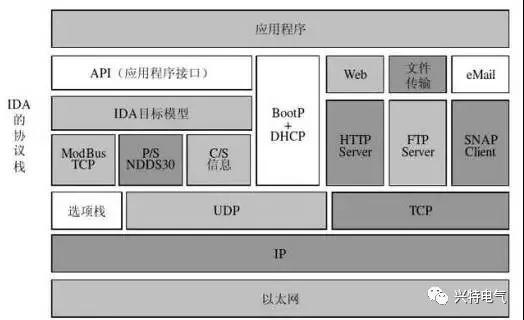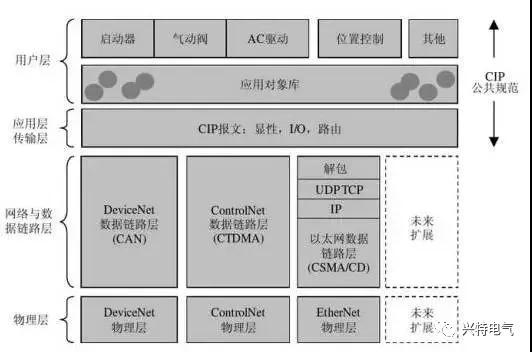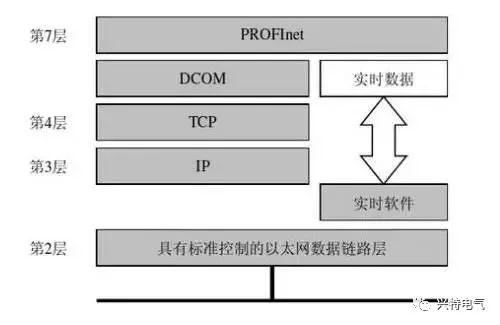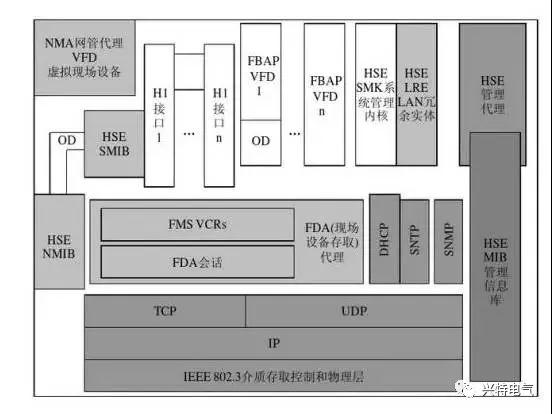Changsha office 0731-88922097
Zhuzhou office 0731-22867780
NEWSINFORMATION |
The article detailedField bus and industrial Ethernet
Category: other
Date: 2017-12-26
Click: 2307
Collection:
With the development of "industry 4.0" strategy, the development of computer technology, communication technology and IT technology has penetrated into the field of industrial control. The extensive use of industrial fieldbus technology and industrial Ethernet technology has brought profound changes to automation technology. The fieldbus Fieldbus is a digital, bidirectional, multi-branch communication network which is used in the production field to connect the intelligent field equipment and the automatic measurement control system. It is an industrial data bus and an underlying data communication network in the field of automation. Control of 1. Fieldbus control system The control system software includes configuration software, maintenance software, simulation software, equipment software and monitoring software. Firstly, the configuration software and MMI are selected. Through the configuration software, the connection between functional blocks is completed, and the parameters of functional blocks are selected for network configuration. In the process of network operation, the system collects data, processes data and calculates data in real time. Optimization control and logic control alarm, monitor, display, report, etc. 2. Field bus measurement system It is characterized by multivariable and high-performance measurement, so that the measuring instrument has more functions such as computing power. Digital signal is adopted, which has the characteristics of high resolution, high accuracy, strong anti-interference distortion ability, etc. At the same time, it also has the status information of the instrument equipment, which can be adjusted for the processing process. 3. Equipment management system It can provide diagnostic information, management information, equipment operation status information (including intelligent instrument) and equipment manufacturing information provided by the manufacturer. 4. Bus system computer service module The server represents the data source (provider), and the application client represents the data consumer, which takes data from the data source and processes it further. The client runs on a PC or workstation. Servers run on minicomputers or mainframes, and use intelligence, resources, and data from both sides to accomplish tasks. 5.Database. Organized, dynamic storage of a large number of relevant data and applications, to achieve full data sharing, cross access, with a high degree of independence. In the process of operation, the parameters of industrial equipment change continuously, the amount of data is large, and the real-time requirements of operation and control are very high. 6. Hardware and software of the network system Network system hardware: system management host, server, gateway, protocol converter, hub, user computer and other low-level intelligent instruments Network system software: NetWarc, LAN Mangger, Vines Server operating software: Lenix, OS /2, windowNT, application software database, communication protocol, network management protocol, etc. Classification of the bus At present, there are about 40 kinds of fieldbuses in the world, most of which are used in the fields of process automation, medicine, processing and manufacturing, transportation, national defense, aerospace, agriculture and buildings. The current industrial bus network can be classified into three categories: 485 network, HART network and FieldBUS network. 1.485 networks RS485/MODBUS is a popular industrial networking mode, which is characterized by simple and convenient implementation, and there are many instruments supporting RS485. Today's instrumentation vendors are switching to RS485/MODBUS for the simple reason that RS485's switching interfaces are not only cheaper but also more varied. At least in the low-end market, RS485/MODBUS will still be the most important industrial networking mode. 2. HART network HART is a transitional pci standard proposed by Emerson, which is mainly characterized by the superposition of digital signals on 4-20 ma current signals. However, this protocol is not really open, and the agreement can only be obtained by joining his foundation, which requires a certain fee. HART technology is mainly monopolized by several large foreign companies. In recent years, some domestic companies are doing it, but it has not reached the level of foreign companies. 3.FieldBus network Fieldbus is one of the hot technologies in the field of automation. Its appearance marks the beginning of a new era of automatic control technology. Fieldbus is a digital, serial and multi-station communication network connecting the instrument in the control field and the control device in the control room. Its key mark is that it can support bidirectional, multi - node, bus - style full digital communication. Fieldbus technology in recent years become the hotspot in international automation and instrumentation development, it makes the traditional Control System structure produced revolutionary change, make the automatic Control System in the "intellectualization, digitalization, informatization and networking, diversified" in the direction of further and form a new type of network communication of total distributed Control System, Fieldbus Control System FCS (Fieldbus Control System). However, so far, the field bus has not formed a truly unified standard. ProfiBus, CANbus, cc-link and other standards exist in parallel and have their own living space. Industrial Ethernet Industrial Ethernet is technically compatible with commercial Ethernet, but in terms of product design, it meets the needs of industrial field in terms of real-time performance, reliability and environmental adaptability. It is the most recognized and promising industrial communication network developed after field bus. The essence of industrial Ethernet is that Ethernet technology office automation moves towards industrial automation. Comparison between industrial Ethernet and traditional Ethernet networks
Operation requirements 1. The existence of high temperature, humidity, air pollution and corrosive gas in industrial production environment requires the industrial grade products to have the adaptability of climate and environment, and to be corrosion resistant, dustproof and waterproof. 2. For the presence of dust, flammable, explosive and toxic gases in industrial production sites, explosion-proof measures shall be taken to ensure safe production. 3. Due to the large vibration and electromagnetic interference in the industrial production site, the industrial control network must have mechanical environmental adaptability (such as vibration and impact resistance), electromagnetic environmental adaptability or electromagnetic compatibility (EMC), etc. 4. The power supply of industrial network devices is usually based on the standard of low-voltage dc power supply in the cabinet. In most industrial environments, the power supply required in the control cabinet is low-voltage 24V dc. 5. Standard guide rail is adopted for installation, which is convenient to install and applicable to the requirements of industrial environment installation. Industrial network devices should be easily installed in the control cabinet of industrial site and easy to be replaced. The main criteria Industrial Ethernet is according to the requirements of industrial control, the development of appropriate application layer and user layer protocol, the Ethernet and TCP/IP technology is applied to the real control layer, layer extends to the site, and in the information as much as possible, using all effective and latest achievements IT industry, therefore, application of industrial Ethernet with the Ethernet in the industry is not completely the same concept. 1.IDA communication structure and communication protocol
DA is an industrial Ethernet specification based entirely on Ethernet, combining a real-time web-based distributed automation environment with a centralized security architecture with the goal of creating a distributed automation solution based on TCP/IP. 2.Ethernet/IP communication structure and protocols
In addition to owning DviceNET and ControlNet, ODVA also controls another bus EtherNet/IP, which bundles the target library CIP (including all classic PLC operations) for both application and user layer DeviceNet and ControlNet with EtherNet physical media.
As shown in the figure, its data link layer adopts a transmission protocol designed to reduce the time needed to process the communication stack, thus greatly reducing the refresh time of the network and ensuring the refresh time within 5~10MS. In addition to circular transmission, real-time channel can also complete non-circular transmission (event triggering, process data modification, operation instruction issuing, etc.). It also adds network management, WEB functionality, and direct integration of I/O devices. 4. Communication structure and protocol of HSE
Application to industrial control problems to be solved Industrial Ethernet, generally speaking, is technically compatible with commercial Ethernet, but in product design, it can meet the needs of industrial field in terms of real-time performance, reliability and environmental adaptability. It is a typical industrial communication network. Compared with commercial Ethernet, industrial Ethernet has special requirements in the following aspects: 1. High real-time performance and good time certainty are required; 2. Most of the transmitted information is short frame information, and the information exchange is frequent; 3. Strong fault tolerance, good reliability and security; 4. The control network structure is highly decentralized; 5. Simple and practical control network protocol and high work efficiency; 6. Intelligent control equipment and autonomy of control functions; 7. It has efficient communication with the information network and is easy to integrate with the information network; 8. Equipment reliability and environmental adaptability; 9. Long-distance transmission; 10. Bus power supply; 11. Network security; 12. Interoperability. Changsha Hing special General Electric Co.Ltd Address: room 807, chuangye building, lugu enterprise square, no.27 wenxuan road, high-tech zone, changsha, hunan Telephone: 0731-88922097 88614760 88927559 89707759 Fax: 0731-88922440 |






